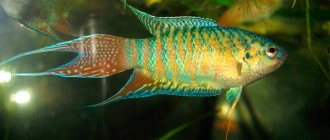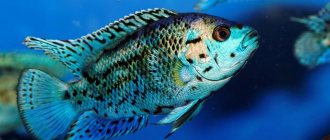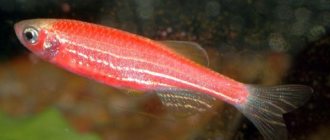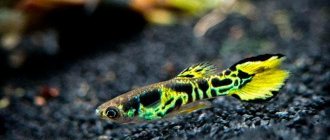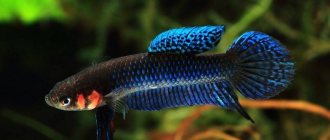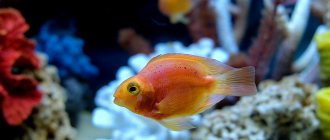What fish are called viviparous?
Viviparous fish are those fish that do not lay eggs during spawning, but give birth to live fry that are already adapted to the environment.
But this process cannot be called viviparity, as in higher animals. The fry still form and grow for a long time in the eggs located in the mother’s abdomen. Only after this are they born. Therefore, sometimes fish are not called viviparous, like higher animals, but ovoviviparous. Livebearers are distinguished by their endurance and ease of care.
Popular types
The famous aquarist Bernd Poseckert described in his works some popular species, including viviparous aquarium fish species. Most often, small-sized fish with a calm character that are peaceful with other species are chosen for aquariums.
Houdiaceae
The Gundeev family is a transitional stage between fish that lay eggs and viviparous creatures. They live in the mountain rivers of Mexico. The name is given in honor of the ichthyologist D. Goode.
The Gudievs have a high body, laterally compressed. Females are larger than males by a couple of centimeters and have a duller color. Life expectancy is 3–4 years.
Representatives of the Gudiev family require a tank of 50 liters or more. Frequent water changes, aeration and filtration are required.
Guppy
These fish are considered the most common inhabitants of aquariums and tanks with underwater pets. The species differs from others in its bright body color. Breeders developed colors ranging from white to black. A distinctive feature is the long veil-like caudal, lateral and dorsal fins of guppies in males.
The body length of the aquarium guppy fish is 2–6 cm. Females are much larger than males and have a more modest appearance that hides them from enemies.
Suitable for keeping in cramped conditions - an aquarium for fish from the viviparous family with a volume of 15-17 liters and a minimum amount of equipment will be enough. Guppies easily forgive beginners' mistakes in care, so they are recommended as a first pet for an inexperienced aquarist.
sword bearer
In its natural environment it lives in lakes and rivers of Central America. It is not inferior to the guppies in popularity.
The color of the fish in nature is pale red or greenish, but thanks to selection, bright color variations from yellow to black have been developed. But most people know this species for its traditional red-orange body and long arrow with a black stripe on the males' tail, from which it got its name.
And also suitable for beginners. Not picky about food and water parameters, swordtail aquarium fish are able to endure long hunger strikes and feed on plant foods.
Mollies
The species is distributed in the center and south of America, in Yutacan, Texas and Colombia. Belongs to the Petsiliev family.
In nature, the color of fish ranges from yellow-sandy to gray-spotted. In the 19th century, this species was discovered and became widespread. The natural color was popular, but over time, mollies began to be characterized as fish with a jet-black body color. Mollies are also noticeable due to their developing fins. In size, females predominate and grow up to 9 cm, and the male’s body length is 6 cm.
Mollies require careful maintenance. She will need an aquarium with a capacity of more than 65 liters of water and rich lighting.
Mollies do not show aggressiveness and get along calmly with other species, but intraspecific clashes between males are possible, especially during the spawning period.
Pecilia
The species Pecilia is part of the Pecilia family. The place of distribution in nature is the north and center of America, found in Guatemala. Brought from America in the twentieth century, since then they have become widely known and loved by aquarists.
In nature, it has a more modest color - yellow-gray with dark spots near the tail. But breeders have developed several more colors of platies.
The body length of both sexes is 5–6 cm. The body of the fish is shortened, with a voluminous abdomen and an upward snout.
Platies do not need large spaces. A tank of 5–6 liters will be enough for two platies, and a school of 7–8 fish will need 40–50 liters. Careful aeration and bright lighting are required.
Ameka
The species is the only one belonging to the genus Ameca. In its natural environment it was completely exterminated in 1996; it previously lived in the rivers of Mexico. But this fish is bred in captivity.
The body is laterally flattened, grows up to 5–12 cm. The body color is sandy-silver with black spots all over the body. A distinctive feature of the species is the bright yellow edging of the tail and anal fin. At night, the black side stripe becomes brighter, but during the day it becomes less noticeable.
Ameka is a schooling fish with a strict hierarchy and distribution of positions. Fights and skirmishes between males are possible.
Ghirardinus
Originally from South America, it prefers to live in stagnant water of lakes, creeks, and swamps.
The size of females is 6 cm, and males are 3 cm. Females are more massive and large, while males are small and graceful. The color ranges from yellow to silver, the whole body is covered with small black spots.
Ghirardinus will be a good assistant in learning aquariums. The fish is not demanding; a volume of 40 liters is suitable for a flock.
Formosa
This pet attracts attention with its unusual appearance. Although some do not consider it beautiful, fans of this species are glad to have such a creature at home.
Distribution area - Southeast Asia: Thailand, Java, Singapore. Lives in mangrove forests near coastal waters.
Formosa has a highly elongated and elongated body. The fins are located far behind. The lower and upper jaws differ in structure: the upper one is much shorter than the lower one. This mouth structure facilitates the extraction of food from the surface of the liquid. The body is colored sandy gray, and the fins have a reddish tint.
Sail mollies
A species from the Poeciliidae family and the class of ray-finned fish. It lives on the Yutakan Peninsula in brackish water bodies.
The size of females reaches 15 cm, and males 17 cm. The sail-shaped mollies have pronounced sexual dimorphism. The body is gray with shiny dots. The lower part has a golden color.
Cyprinodontiformes
Cyprinodontiformes are an order included in the class of ray-finned fish. This order includes more than 400 species of freshwater fish in Africa, America and Asia.
The name Carp-toothed came from the external similarity of the order with species from the order Carpidae. But the difference was the absence of teeth in Cyprinidae, which are present in Cyprinodontiformes.
Multiple colors have been artificially bred.
Xenotoka
Habitat in nature - mountain rivers and lakes of Mexico. Discovered in 1974 and since then has gained popularity among aquarists.
The body is laterally compressed; males have a hump above their heads, which makes the head appear disproportionately small when compared with the body. The male's body color ranges from pale brown to bluish-gray. A yellow spot begins at the caudal fin, the same color as the caudal fin itself. The body size usually does not exceed 8 cm.
When keeping xenocurrents, plant a sufficient amount of vegetation near them.
Limia
It was first discovered in the Caribbean Sea, near the island of Haiti. It lives in small lakes and shallow waters with a lot of plants. Limia is a schooling fish and keeping it alone in an aquarium will lead to stress or even death of the fish.
Limia grows up to 6–7 cm, but the males are smaller and look more elegant and graceful. The predominant color is silver, with yellow areas on the head and belly. Limia differ from others by their characteristic vertical stripes. The caudal fin is also most often pale yellow. The dorsal fin is round in shape and colored black and yellow with marbled stripes.
Limia is an unpretentious and easily adaptable species, so it fails beginners. A flock of Lilias will do well in a 35-40 liter tank with vegetation.
Half-snout
Half-snout, or in other words Dermogenis, belongs to the Half-snout family. The strange name and bizarre appearance attract attention. An unpretentious pet will be an addition to the aquarium’s biosystem.
The habitat lies in South and East Asia, Malaysia and Singapore. Found in bodies of water with weak currents and abundant amounts of silt and driftwood at the bottom.
The body is long and slender, the color varies from gray to blue. The fins have blue edges. The half-snout has an unusual structure of the oral cavity: the upper jaw is much shorter than the lower jaw. This is due to the feeding habits of this species. Half-snouts capture insects and invertebrates caught on the surface of the water. There is a “hook” on the lower jaw.
Iliodon
Lives in rivers and lakes of Mexico. The body is elongated and laterally flattened. The dorsal fin is not located in the middle of the back, as in most fish, but closer to the tail. The color is gray with a green-olive tint. Light lines are visible on the sides, on which there are black spots. The abdomen is pale yellowish. The body length is 8–12 cm, with females being larger.
Iliodons have an aggressive temperament and territorial behavior. It's better to keep a group. A strict hierarchy is preserved and maintained in the group and each fish has its own place. They live in the upper and middle layers of water.
In an aquarium with 8–10 individuals, 40–50 liters of water with a large amount of dissolved oxygen is sufficient.
Features of care
Viviparous aquariums are easy to care for and not too demanding on living conditions. Livebearers are highly adaptable to new living conditions and are able to tolerate temperature changes, lack of oxygen, water pollution or insufficient lighting.
List of care features:
- To keep your pets healthy and comfortable, they will need adequate lighting. This can be daylight or artificial light. If you choose natural daylight, the aquarium should be located near a window to prevent drafts. And also if daylight hours are insufficient, then use additional lighting. Good lighting will help the fish feel normal and fully reveal their color, which fades when there is insufficient lighting.
- Livebearers feed on all types of plant and animal food: dry, frozen, live. The diet must contain plant components, vegetables, and fruits. Their number can reach up to half of the total feed volume. When feeding vegetables and fruits, they are first doused with boiling water and only then are they fed to the fish. Sexually mature individuals are fed once a day, and fry require 4 servings of food per day. For the fry, the food is thoroughly crushed. In times of famine they are able to feed only on plants.
- More often, viviparous fish are school animals, so keeping them alone is dangerous for the psyche of the fish. To avoid skirmishes and fights in a large aquarium population, you should not allow a large number of males. Match 2–4 females to each male individual. Then the likelihood of fights will decrease.
- Although livebearers are able to survive in unfavorable conditions, it is better to maintain clean water in the aquarium by changing some of the water every week.
- The water temperature is from 20 to 30 degrees Celsius, and the hardness and acidity levels are average.
- Conditions should be close to natural. Plant enough vegetation.
- It is recommended to equip the tank with aerating and filtering devices.
Viviparous aquarium fish are hardy and unpretentious:
- The temperature regime is not very important and its spread can be wide.
- Livebearers do not care about the size of the aquarium - most of them are able to feel comfortable in the cramped conditions of a small aquarium.
- The hardness of the water also does not matter much, and the water can be either soft or highly hard.
- Reproduction of livebearers is not difficult.
Conditions of detention
Goldfish can grow quite large, up to 15-25 cm. The aquarium for them should be spacious (from 200 liters), with very good filtration and aeration. It requires regular water changes. Goldfish love to dig, so the decorations in the aquarium must be securely fastened. In addition, when choosing them, preference should be given to rounded, non-sharp elements in order to avoid injury to the decorative parts of the fish’s body. Goldfish are unpretentious and perfect for beginners. They feel comfortable at average and below average water temperatures (+15...+28 degrees), while preferring fairly hard (up to 20 -25 dGH) water with a wide range of acidity (6-8 pH).
Reproduction
The distinctive features of viviparous species are that they reproduce easily in an aquarium and have high fertility.
Puberty of fish occurs at 4 months after birth.
The female develops eggs in her abdomen, and the male fertilizes them with seminal fluid using the gonopodium. During pregnancy, the abdomen becomes rounded, and as birth approaches, a dark spot appears near the anal fin. The eggs hatch after a month and a half and are born. After 1 fertilization by a male, a female is capable of giving birth 3–4 more times. At one time, a female can give birth to up to 170 fry.
After birth, the fry float to the surface of the water, expand their swim bladder with air and are already able to live independently. They begin to feed on the second day of life.
For a comfortable stay, you will need plants in which the fry can hide after birth, for example, riccia. Adult fish and fry are kept in separate tanks because fish often eat their young. When kept together, the inhabitants are provided with a sufficient amount of food, then the fry will survive.
Differences between female and male
Female and male livebearers are easily distinguishable from each other. In almost all species, females are larger and more massive, and males are small and graceful. Females are endowed with a discreet and grayish color, while males are bright, with long fins of different shapes.
But the main difference will be the shape of the anal fin: in mature males it lengthens and turns into an organ for fertilizing eggs inside the female - gonopodium. In females, the anal fin has a rounded shape and small size.
Maintenance and care
The maintenance and care of platies, regardless of the variety, have common features and characteristics that must be taken into account. Pecilia aquarium fish prefers to lead a gregarious lifestyle, so pets are kept in a small group - from eight individuals or more. An aquarium for a flock should have a minimum capacity of 50–60 liters, and one fish should have at least 4 liters of water.
Water indicators:
- hardness – 8–25 dH;
- acidity – 7.5–8 pH;
- temperature – 20–25C.
The water is renewed weekly, replacing 1/3 of the volume. Aeration is set to moderate, and the aerator must work constantly. Lighting is set to moderate, placing light bulbs above the pond.
As a substrate, aquarists prefer to use river sand or fine gravel, while the substrate is chosen in dark tones - they shade the fish more favorably. The vegetation is planted alive, dense and spreading, since the phenotype likes to hide in thickets. For swimming, a free area is left in front. The following unpretentious types of flora are well suited:
- Vallisneria;
- hygrophila;
- riccia;
- salvinia;
- hornwort;
- Echinodorus;
- elodea.
conclusions
Viviparous fish are considered the best first pets for beginning aquarists. These creatures are easy to care for and attract attention with their bright colors and behavior.
Livebearers are versatile and can live in both freshwater and marine aquariums. These features make viviparous fish an excellent choice for adding to an aquarium. With their help, each tank will become a source of beauty, and will allow you to enjoy the closeness of nature in your home.
Previous FishTernetia - a peaceful relative of piranhas Next
FishPeaceful and shy pelvicachromis pulchera
Swordtails
Another common, bright representative of the aquarium world, which is suitable for beginners. Swordtails are so beloved by breeders that today you can find many varieties that differ in shape and color. The fish got their name due to their elongated caudal fin, which resembles a “sword” in shape. But only males have this distinctive feature.
The swordtail is a small fish (8-10 cm long), but schooling, and one “family” requires a 30-50 liter tank. The optimal water temperature can vary from 20° to 26°C. It is important to change the water every week by 25–35% of the total volume.
“Swords” get along with many inhabitants, who are just as peaceful and small. But it is not recommended to plant them in the same aquarium with goldfish, since the latter will hunt and eat those who stray from the flock. The relationships within the flock are worse - the males compete fiercely with each other. Therefore, it is recommended to start a flock consisting of only 2/3 females, this will reduce tension.
Representatives of the breed have good health and are able to withstand significant drops in temperature. In addition, these fish can go up to 2 weeks without food, without significant damage to the body.

